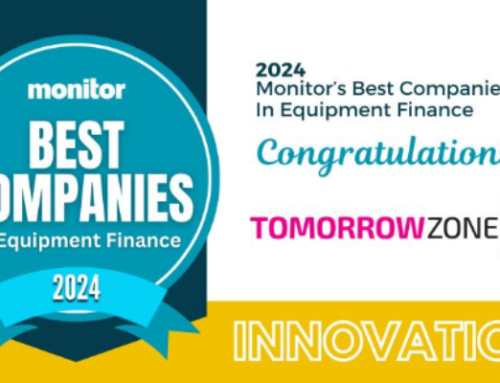
This article was originally published by MonitorDaily in March 2023.
Reprinted with permission from the author.
How are your improv skills? Improvisation can be measured by your ability to play and be in the moment. Deborah Reuben interviews bestselling author Jeff Rogers about how improv relates to design thinking and can protect us from disruption.
Equipment Finance leaders and teams often struggle to move beyond incremental improvement and genuinely innovate. I sat down with bestselling author, award-winning television host, speaker and improv guru Jeff Rogers to learn how we can spark innovation with the “Playmaker Mindset.” The following is our interview (edited for clarity and conciseness).
Deborah Reuben: How would you describe yourself?
Jeff Rogers: I’m an improvisation evangelist; my improv background comes from a famous theater called, The Second City in Chicago. I worked in improvisation with many well-known comedians like Steve Carell, Stephen Colbert, Tina Faye, Jim Belushi, Bonnie Hunt and even the voice of Homer Simpson. They were crazy funny people and delightful human beings. Improvisation was my gateway to innovation. It can be applied anywhere.
Jeff Rogers, Speaker, Design Thinking Facilitator & Author
Now I help companies who want to install innovation culture but are stuck, unsure how to do it. I help them understand how to create, collaborate and communicate to lay the groundwork for more innovation.
Reuben: How do you define innovation?
Rogers: Innovation has multiple meanings. People think about it as creativity, imagination, evolution and revolution. In part, they are all correct. Innovation is all those things at specific times. You must have a process to identify where you are and which aspect of innovation to apply at a particular time.
Imagination — the idea that anything is possible; nothing is impossible. It’s not innovation. You need imagination to feed creativity; the ability to think of things that are possible, and that might be feasible. And then, move from imagination and creativity to innovation, applying creative solutions to specific areas you work on, whether a task, strategy, product, or service. Innovation is applied creativity.
Reuben: What is the playmaker mindset?
Rogers: The playmaker mindset is all about lowering the stakes. Getting people into the same mental space as when they play; lowering the stakes raises their game. When nervous or struggling, our whole field of vision narrows. The lizard brain says, “just focus on this one thing.” With creativity, we want to be as open as possible to see different ways that ideas, knowledge and experience can be pulled together, forming imaginative new ideas we can polish into innovations. Beyond creativity, you must put ideas through a process to apply to your situation.
Creativity is very personal, so you must create a space where someone can offer an idea that may be silly or unhelpful. Psychological safety is creating environments where people feel safe enough to offer ideas. It’s hard to do, especially if you are continually task-focused and then suddenly asked to share ideas. When a group comes together, it’s never about the first idea; it’s always the fifth or sixth one where we start to develop something useful. Or it’s a combination of ideas. Lower the stakes about the ideas; go for quantity instead of immediate quality.
People think they don’t know how to improvise. If you’ve ever been a kid, and most of us have, you know how to improvise. You do it because it’s about playing, being in the moment. When a kid asks another kid, “Do you want to play?” the other one says, “OK, let’s go play.” They don’t say, “OK, I’ve got a list of needs, and I want to ensure we achieve these goals about our play together.” No, they play, explore, fail, learn and grow. That’s what needs to happen at the beginning of the innovation process. In companies, you need to create a space where people can offer ideas and feel safe about doing that.
It’s also important to get out of a narrow and reactive mindset; instead, respond to the situation or need. “We need to put a bandage on this cut.” That’s an example of a reaction. Responding would look like, “Let’s clean it out, make sure nothing else is in there, maybe apply some antibiotic, then put a bandage on there if that is appropriate, or maybe we will use a spray-on bandage.” There are lots of ways to go about it. Lower-stakes environments enable clear thinking and responding to come up with solutions that work. That’s the playmaker mindset.
Although [I’m] not great at sports, one thing I learned from a baseball coach [is] it doesn’t matter what sport it is, if your feet are shoulder-width apart and knees a little bent, you can go anywhere quickly. It’s readiness sensibility. When playing, you don’t know what’s coming next; you’re just ready. A readiness state helps you leapfrog into great ideas and innovations.
Reuben: How might improvisation help us deal with disruption?
Rogers: Three keys to improv are “Listen, adapt, yes, and.” Number one, deeply listen with empathy. Number two, adapt to reality in the moment; not preconceiving outcomes, but shaping outcomes by responding instead of reacting. Number three, “yes, and.” Many don’t understand this technique. It’s not about saying “yes, and” to whatever others come up with, but agreeing that they have the right to say it. “Yes” is acceptance. You accept their right to their opinion. “And” is the bridge from where they are to where you are, communicating and connecting ideas. Team bonding is built into the process; not just a tool for stage or comedy; improv is a life skill applicable anywhere.
Reuben: How might improv serve as a meta-skill?
Rogers: Improv history goes back to the Renaissance, even Greek theater. Viola Spolin,1 started the current wave of improvisation creating improvisation games and exercises, for children of Chicago immigrants. Unable to speak each other’s languages, she created games they could play, taking on characters, and expressing themselves, without sharing language. Understanding what the other person is doing without understanding the words is an intense level of listening; it’s empathy.
There is no scenario where empathy is not a boon to what you’re doing. Sales, empathy. If you can understand your customer and your client’s needs, they feel like you get them. HR is about empathy — understanding both sides of a worker and management scenario. Communication, “yes, and-ing,” and accepting what someone is saying; trying to build a bridge. Who isn’t for that? It’s the heart of negotiation used every day in business.
Finally, adapt to what’s real and in the moment. Forecasters get things wrong when using a past frame of reference, unable to see what’s happening in the moment. Your past is relevant but shouldn’t be the only lens for studying your situation. Spolin’s idea of improvisation is about being spontaneous in the moment, overcoming biases and throwing off your handed-down frame of reference, seeing things as they are, and being present in the moment.
Envisioning the future requires honesty about where you’re at and not being constrained by the solutions of the past. There’s always a temptation or bias to start with your favorite solution first. It’s never the first idea. Getting into the improv zone more often is a superpower. As a meta-skill, the tools of improv can be applied in every scenario.
Reuben: How does improv relate to design thinking?
Rogers: I have taken several courses on design thinking. MIT has more of an engineering take on innovation and design thinking. Stanford developed the whole human-centered design mindset. Harvard has been a fascinating combination of those but focusing on how we think.
Once we overcome the courage gap, we step into a space of vulnerability requiring different modalities of thinking to shake us out of our current frame of reference. Asking new questions. How would this work in an alternate world? An adjacent industry? A non-adjacent vertical or industry? For example, an airline’s people could go to a spa to understand service levels, communication and getting people into a relaxed state. These ideas could be incorporated into approaches for dealing with irate passengers. Reframing helps you tap into new ideas.
When first trained in design thinking, I immediately connected it to improvisation. We accept all ideas in a non-judgmental environment to create comedy on the stage. Design thinking is a mental game. Some people can do it immediately. Most need a bridge to get into that thinking space. That’s where improv comes in, helping you get into that creative fun space of constant readiness to throw different, ingredients into the creative mix.
Reuben: What about brains and improv?
Rogers: Researchers did an MRI on a jazz musician playing the piano. They asked him to play a piece of music as written; then improvise. While improvising, they saw all these different areas of his brain light up: sight, sound, memory and smell. We store memories all over our brains. So, they investigated, why smell? As a kid, he would go to grandma’s house; she wouldn’t allow any freshly baked cookies until he finished his piano lesson. Sometimes during the lesson, he would improvise. His brain anchored freestyling in jazz with the smell of cookies. Improvisation uses way more of your brain. Once you activate and open your brain in this way, it can tap into more memories to create connections and new ideas.
Reuben: How does play fit into work?
Rogers: Most people think that work is the opposite of play. It’s not. The opposite of play is depression. When you are working, having an incredibly great day, you’re engaged, hitting on all levels, enjoying it, people are attracted to you. That’s no different from a sense of play. I ask business leaders, what feeling do you want employees to have when thinking about coming to work? Excited and motivated or depressed and regretful? Most choose excited and motivated. Some take longer with the decision than I’m comfortable with.
Wouldn’t it be great to find happiness and joy at work and be inspired by what we do? The next generation is seeking that. Focusing on and investing in employees isn’t about ping pong tables and extra snacks but identifying and living vision and values as a company. Work should be fun, challenging and engaging. We want to work at that nexus of what we know how to do and what’s challenging to us.
Reuben: How can leaders shape their tomorrow?
Rogers: Without a doubt, the first thing is, to take care of your employees. Understand your internal customer needs first; if you can figure that out, you’re bulletproof. They will become ambassadors for the company. If they believe in what the company is doing and why they’re doing it, why would they go anywhere else? It’s not magic, but understanding your employees is foundational to generating more revenue, leadership attributes and a better core team.
1Learn more about the history of improv and Viola Spolin at violaspolin.org
Jeff Rogers is a sought-after speaker, design thinking facilitator, and author of the bestseller, The Playmaker Mindset: A Radically Fun Way To Build A Culture Of Teamwork And Instant Innovation. Owner of the first original improv school in the country, his corporate clients include Fortune 500 companies across all industry verticals. Learn more at meetjeffrogers.com.
ABOUT THE AUTHOR: Deborah Reuben, CLFP, is CEO and founder of TomorrowZone, an innovative consulting firm bringing forward-thinking insights and original ideas to help companies gain efficiencies and design roadmaps for the future. She holds many industry leadership positions and authored The Certified Lease & Finance Professionals’ Handbook 6th-9th editions. Learn more at tomorrowzone.io.





